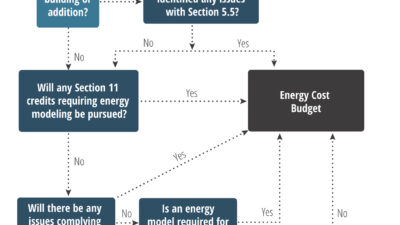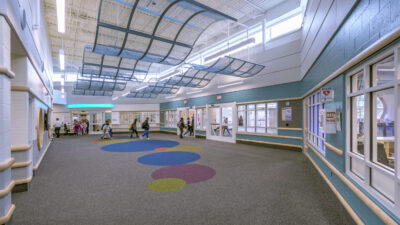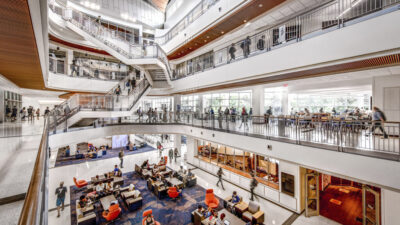CONSULTING-SPECIFYING ENGINEER: What are some common errors designers make when specifying environmental control systems? TOM: Engineers tend to overspecify control hardware technical details, while underspecifying control of HVAC hardware. To some extent, this is probably a result of the fact that many control system vendors have a vested interest in selling their own hardware, so their specif...
CONSULTING-SPECIFYING ENGINEER: What are some common errors designers make when specifying environmental control systems?
TOM: Engineers tend to overspecify control hardware technical details, while underspecifying control of HVAC hardware. To some extent, this is probably a result of the fact that many control system vendors have a vested interest in selling their own hardware, so their specifications are carefully designed to match their equipment and exclude their competitors. When a specification includes details like “controllers shall utilize a 16-bit microprocessor with an 8-bit communication coprocessor and a 12-bit A/D converter,” it is clearly an indication that the spec has been written around a specific vendor’s product line. Of course, this is fine if the engineer wants to limit bidding to that one vendor. But if the purpose is to obtain a competitive price, it will fail. Engineers often compare multiple vendor’s specs and try to achieve some common ground, but if the engineer tries to provide the same level of detail, it is all too easy to create a meaningless spec or one that specifies hardware that no vendor manufacturers.
On the other hand, details about the required control strategies, control points, trends, alarms and the like for individual pieces of HVAC equipment are often woe-fully inadequate. A typical control vendor’s sample specification won’t describe specific HVAC control routines, so if a vendor’s spec is used as a model, the result will be weak. It is common to see a specification that goes into great detail concerning the trending capabilities of the hardware, but doesn’t specify a single point to be trended. At best, this gives the operator a toolkit that he can use to create his own trend graphs, but he will need to do so because the system will be provided with no graphs whatsoever. At worst, the system will not have the memory or the flexibility needed to trend all the points the operator wants to see.
CSE: How about the practice of “cutting and pasting” from previous specs?
TOM: This often leads to problems of conflicting specification paragraphs, missing text, unwanted text or obsolete technical details. The net result is a spec that is difficult, if not impossible, to enforce. Often, this makes the specifying engineer reluctant to even try to enforce the spec, and encourages some bidders to ignore a section that they don’t like, on the assumption that it won’t be enforced.
WESTPHAL: Designers also often fail to specify well-coordinated sequences of operation for optimal performance. For example, they specify an open system but then place no requirements of proof of capability on the vendors. They may also specify sequences of operation that are too complicated or confusing for the operator to use and maintain effectively.
ATASSI: In general, I think that most designers do a great job, though some look only at the small picture. They are oftentimes focused on a single technology and limit their choices with respect to the different BAS on the market today. Some designers lack an in-depth knowledge of IT technology and often specify systems that are not compatible with a facility’s infrastructure.
CSE: What are some ways to prevent these mistakes?
ATASSI: There are a number of strategies that can collectively help in avoiding these issues: getting involved and keeping up-to-date with technologies; participating in user/consultant focus groups and symposia; and becoming familiar with the end users’ current and future needs, as well as the market dynamics that affect those needs. All of these strategies help designers develop and specify the technology that brings long-term value to their clients.
WESTPHAL: When specifying an open system, the specifier should hold a “plugfest” to confirm that the qualified vendors can indeed interact with each others’ equipment in the manner required by the specification. Another important way to prevent mistakes is to actively participate in organizations like ASHRAE to learn the issues and new technologies. It’s important to get beyond knowing the buzzwords and move on to an understanding of the concepts behind the latest features.
TOM: I have three suggestions. First, consulting engineers should not model a spec on a vendor-specific document. Instead, an independent source, such as ASHRAE Guideline 13-2000, should be used as reference.
Second, industry-standard terms and configurations should be used for hardware specifications. The ASHRAE BACnet specification defines several levels of controllers—from smart sensor through building controller—that are available through multiple vendors. Specifying a BACnet Testing Lab (BTL)-certified device will put teeth into this requirement. Alternatively, one could go to the DDC-Online web site, compare the capabilities of multiple vendors’ systems and create a specification that multiple vendors can meet. With this approach, one needs to be careful to focus on function and performance, rather than locking into an architecture that is specific to one or two vendors.
Finally, provide a sequence of control for every piece of HVAC equipment in the system, complete with a points list that specifically identifies the hardware and software points that need to be trended, alarmed and shown on graphics. Samples are available in many textbooks and vendor’s catalogs, although one needs to take care to avoid specifying a proprietary function. ASHRAE is preparing a document that provides sample sequences for many common equipment types, but this is not yet available to the public. In the meantime, a web site that generates non-proprietary sequences is available at www.CtrlSpecBuilder.com .
CSE: Switching gears a little, let’s transition to the technology itself. How has environmental control technology improved over the past few years?
WESTPHAL: Ever-increasing microprocessor power, the drop in the cost of memory and improvements in software technologies have all led to greater ease of use and better control. These advances have also made it possible to incorporate Ethernet, which gives operators high-speed systems access from anywhere in the world via the Internet.
ATASSI: The technology has also become more modular and flexible. Application-specific controllers are now widely used, because they are pre-programmed and cost-effective. And BAS has more integration capabilities that enable the end user to achieve a better interface with various M/E systems within a building and throughout the campus. Better interfacing capabilities not only allow for better control and monitoring, but also enable more detailed systems information, leading to more efficient and safer building operation.
CSE: Speaking of the Internet, how far have web/PDA-based features evolved?
TOM: It’s been more of a revolution than evolution. Five years ago, the first web-based BAS was introduced. In that short time, features and usability improved dramatically. Today’s features have far surpassed the earliest web-based BAS, with capabilities such as historical trending, report writing, interactive logic, cell phone/PDA support, sensor port access, global modification and web services.
The “back end” tools used to engineer BAS have also evolved significantly, allowing a system designer to provide a complete system in a shorter period of time and at a lower price. In addition, auto-discovery, online database editing, Web DAV [Web-based Distributed Authoring and Versioning], database merge, support for multiple operating systems and databases and built-in commissioning tools have all significantly enhanced the system engineer’s toolbox. And consultants can troubleshoot or optimize systems from anywhere, giving operators access to technical assistance they could never previously afford.
ATASSI: It’s interesting that researchers in life-science facilities have always demanded access to environmental control data as part of their research process. They can now extract such data using web and PDA access—separately from the facility operations personnel.
WESTPHAL: But it’s also the case that while PDAs are being used successfully to access control systems, their rapid evolution makes it a nightmare for designers to keep up with the changes. A more useful tool for the BAS operator is a self-learning interface, such as a wall- or desk-mounted touch-screen display device connected to the system.
CSE: In what ways are environmental control systems yielding greater energy savings?
TOM: They provide the maintenance technician with the tools to keep the system operating as designed. This may sound trivial, but lack of proper maintenance can cause tremendous energy waste. Before DDC systems came on the scene, harried maintenance crews were infamous for pulling the pins out of time clocks and wedging a 2 × 4 into a damper to solve an immediate complaint.
If a DDC system makes it hard to change a schedule, or hides set points within a tangle of line code, a harried technician will do the same thing electronically by locking a point. On the other hand, if the DDC system makes it easy for a technician to enter a temporary schedule for unusual work hours, provides intuitive troubleshooting tools to help find the root cause of a problem and provides intelligent alarming to notify the operator of real problems without harassing him with false alarms, an environmental control system can yield significant energy savings. Additionally, a well-designed environmental control system can save energy by implementing sophisticated control logic that optimizes equipment performance. Engineering texts and trade journals are filled with good ideas about how to obtain peak performance from environmental systems such as adaptive optimal start, demand-based setpoint adjustments and daylight harvesting lighting systems. A key point to remember, though, is that these strategies will only save energy if they are allowed to operate as designed. Combine a good idea with a clumsy user interface, poor documentation and training, a technician who hasn’t been told how the system is supposed to operate and an occupant complaint that has to be solved right now, and the result may not be as energy-efficient as one would like.
WESTPHAL: Major energy savings are achieved through intelligent scheduling of the equipment, which makes sure that equipment is turned off when not required. Control of lighting also has a large effect on saving energy. Other methods to save energy are: logical adjustment of set points; optimum start/stop control; well-planned demand limiting strategies; equipment monitoring to recognize a decrease in performance to schedule maintenance; variable-speed drives; motion/people sensors to control equipment; and better control algorithms that maintain desired setpoints and have effective fallback logic in case of sensor failures. Systems, today, can be used to produce an energy use profile that, in turn, can be used to determine where equipment controls may not be as efficient as they should be, and also show whether the building/campus is operating within the control strategies specified.
ATASSI: Developing a methodical building operation approach, understanding the use of the facility, applying cost-effective monitoring and control technology and well-maintained building systems will absolutely yield the most energy-efficient facilities. However, in some instances, energy savings are overtaken by safety measures. One should also not overlook other critical building environmental parameters and sacrifice important occupant needs to blindly save energy.
Participants
Franco Atassi , Head of the Critical Environments Business, Siemens Building Technologies, Buffalo Grove, Ill.
Steve Tom , Director of Technical Information Automated Logic, Kennesaw, Ga.
Bruce Westphal , Vice President of Research & Development, KMC Controls New Paris, Ind.



